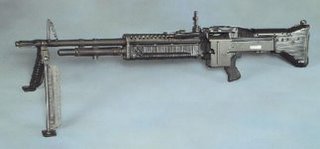Automatic.
This is coolbert:
I have blogged repeatedly how the rifle carried by the modern infantry soldier is a supporting weapon. How the common infantry squad soldier supports with his rifle fire the main weapon of the infantry squad, an automatic weapon of some variety.
[for the purposes of this blog, an infantry squad consists of ten soldiers, as is usually the case in all self respecting armies of the modern era.]
It seems the U.S. Army HAS had a hard time over the last one hundred years in deciding exactly what automatic weapon is to be the base of fire for the conventional infantry squad. The search for the "perfect weapon" has been long and painful, for some reason.
And this for almost a period of one hundred years.
During World War One [WW1], the U.S. army employed the Browning Automatic Rifle [BAR] as the automatic weapon used at squad level. The remainder of the infantry squad used Springfield 03' bolt action rifles.

During both World War Two [WW2] AND the Korean War, the BAR was once again employed as the base of fire for the infantry squad. The common soldier of both wars carried the semi-automatic Garand rifle as the supporting weapon.
In Vietnam, the base of fire for the infantry squad was provided by a troop carrying the M-60 machinegun, the common infantryman carrying the M-16 rifle.

In both Gulf wars, the base of fire for the infantry has been supplied by the Squad Automatic Weapon [SAW], the common soldier in the infantry carrying the same M-16 as was carried in Vietnam.

This is almost a period of one hundred years. And all during that time, the U.S. Army did NOT until recently seem to find the desired weapon to provide the automatic weapon base of fire for the infantry squad.
Each and every weapon seemed to have a drawback.
The BAR was very heavy, and had only a twenty round capacity. A small capacity of ammunition for so heavy a weapon, and a weapon found to have a very high expenditure of ammunition at that. During the Korean conflict, it was found necessary to have a man attached to the weapons man [the man firing the BAR] to act solely as an ammunition carrier.
[originally one man in a squad was designated as BAR man. This troop would have to carry all his own ammo along with the heavy BAR. Ammo carried on the person of the BAR man would be fired off almost in the proverbial heartbeat!! This was recognized as being a deficiency almost instantly!]
In Vietnam, there seemed to be no satisfactory solution to the squad automatic weapon problem other than to use the M-60 machinegun. And there were drawbacks to using this weapon too. Almost an exact copy of the WW2 German MG42, it tended to be overly heavy, as was the predecessor BAR, was designed to be crew served, and used 7.62mm caliber ammunition, as opposed to the 5.56mm caliber M-16. Ammunition was not interchangeable between rifles and automatic weapon in the squad.
[I am not sure about ammunition interchangeability with the Springfield 03', the Garand, and the BAR. It may also be that these weapons too did not have similar rounds. You could not interchange ammo between weapons!!]
The currently used SAW seems to solve a lot of problems with the squad automatic weapon in use by the U.S. Army. Is NOT such a heavy weapon as the BAR or the M-60 for that matter. Has good capacity with belt feed and optional drum magazine. Does have ammunition interchangeability between the SAW and the M-16. This HAS to be a big plus in itself.
Are their drawbacks to the SAW?? Possibly so? But this weapon seems to be a big step forward in solving the squad automatic problem that plagued the U.S. Army for almost one hundred years!! You are NEVER going to find the ideal weapon or combinations of weapons for the common infantry squad. But the SAW perhaps is such a dramatic improvement that it just cannot be denied!
[several comments: In the period when the Garand rifle was replaced by the M-14 as the standard weapon for the common soldier, there was a heavy barrel automatic version of the M-14 that was supposed to be employed as the infantry squad's base of fire. This weapon too had only a twenty round magazine capacity which was found to be deficient. A heavy barrel automatic version of the M-16 also was found to NOT have the desired stopping power the top brass of the day desired!!]
coolbert.

0 Comments:
Post a Comment
Subscribe to Post Comments [Atom]
<< Home